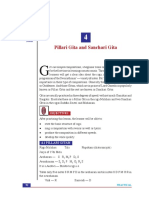Phrygian Locrian 2 1: "The Sooner The Half Steps Come, The More Minor It Sounds."
Phrygian Locrian 2 1: "The Sooner The Half Steps Come, The More Minor It Sounds."
Uploaded by
deffiana lestariCopyright:
Available Formats
Phrygian Locrian 2 1: "The Sooner The Half Steps Come, The More Minor It Sounds."
Phrygian Locrian 2 1: "The Sooner The Half Steps Come, The More Minor It Sounds."
Uploaded by
deffiana lestariOriginal Title
Copyright
Available Formats
Share this document
Did you find this document useful?
Is this content inappropriate?
Copyright:
Available Formats
Phrygian Locrian 2 1: "The Sooner The Half Steps Come, The More Minor It Sounds."
Phrygian Locrian 2 1: "The Sooner The Half Steps Come, The More Minor It Sounds."
Uploaded by
deffiana lestariCopyright:
Available Formats
The seven diatonic modes
from darkest to brightest
using the same tonic
(C D E F G A B C ) (Tonic choice of C is an example only)
Darkest / Saddest 1 Locrian Extremely sad (lacks true 5th) “lowered 2nd & 5th”
Minor
2 Phrygian Sadder “lowered 2nd”
3 Aeolian Natural minor
4 Dorian Brighter or neutral sounding “raised 6th”
5 Mixolydian “Dominant” major (starts on Ionian’s 5th) “lowered 7th”
Major
6 Ionian Major
Brightest / Happiest 7 Lydian Very bright (but lacks true 4th) “raised 4th”
{
{
{
{
1st = 8th degree
“The sooner the half steps come,
7th degree: “wants” to be half step below tonic for major / brighter sound
the more minor it sounds.” 6th degree
True 5th
“Tritone”: dim. 4th or aug. 5th in the extreme modes (“forbidden” sounding)
True 4th
3rd degree: minor/major 3rd above tonic determines whether mode is called “major” or “minor”
2nd degree: “wants” to be whole step above tonic; anywhere else sounds very sad
1st degree: “tonic”
Variations on the Aeolian minor
(C D E F G A B C)
Darkest / Saddest 1 Locrian
2 Phrygian
3 Aeolian Natural Minor
Minor
Harmonic (^7 like major, but has very odd 1-1/2-step gap)
3 Aeolian Natural Minor
Melodic Ascending (^6+^7 like major but odd 5 whole steps)
Melodic Descending (back to natural; sounds surprisingly OK)
4 Dorian
5 Mixolydian
Major
6 Ionian Major
Brightest / Happiest 7 Lydian
{
{
{
{
1 2 3 4 — 5 6 7 1
The seven diatonic modes
using only white keys on the piano
A B C D E F G A B C D E F G
Aeolian A Natural minor
Locrian B Very sad (low 5th; difficult harmony)
Ionian C Major
Dorian D Dorian minor
Phrygian E Sadder minor
Lydian F Brighter major (raised 4th; difficult)
Mixolydian G Duller major (starts on Ionian’s 5th)
© 2002 Chris Thorman
You might also like
- Hack Music Theory For Songwriting PDF v4 25apr2017 PDFDocument17 pagesHack Music Theory For Songwriting PDF v4 25apr2017 PDFchristopher95% (22)
- Space Pirates Eperusal v6 PDFDocument52 pagesSpace Pirates Eperusal v6 PDFYoyo Chan100% (3)
- Blest Are TheyDocument2 pagesBlest Are TheyDennisNo ratings yet
- Mozart - Requiem 3. Dies Irae AnnotatedDocument17 pagesMozart - Requiem 3. Dies Irae AnnotatedAdrian Colborne100% (2)
- The Classical Piano Method: Method Book 3From EverandThe Classical Piano Method: Method Book 3Rating: 5 out of 5 stars5/5 (6)
- Composition For Film - Jack Smalley Sample PagesDocument7 pagesComposition For Film - Jack Smalley Sample Pageslumabox33% (3)
- PDF Concerto Alto Saxophone Amp Trumpet Jean Rivier CompressDocument46 pagesPDF Concerto Alto Saxophone Amp Trumpet Jean Rivier Compressavaigandt100% (2)
- SHREK Mic Plot - XLSX - Sheet1Document3 pagesSHREK Mic Plot - XLSX - Sheet1Chloe PetersenNo ratings yet
- Grade 8 Aural NotesDocument3 pagesGrade 8 Aural NotesWang Xin YiNo ratings yet
- Music Scales and Modes PDFDocument6 pagesMusic Scales and Modes PDFPeter100% (4)
- The Lydian Dominant Scale - Dare To Venture Outside Major and MinorDocument9 pagesThe Lydian Dominant Scale - Dare To Venture Outside Major and Minorgrayburn_1No ratings yet
- Kenny Werner Harmony Name All Chords PDFDocument1 pageKenny Werner Harmony Name All Chords PDFvaffan8888No ratings yet
- Papanasam Sivan Songs LyricsDocument9 pagesPapanasam Sivan Songs LyricsArun Achalam33% (3)
- Chord Family The Question To Ask: A Brief Sumary of Jazz Scale UseDocument1 pageChord Family The Question To Ask: A Brief Sumary of Jazz Scale UseJulian RoaNo ratings yet
- Intervals & Scales Cheat SheetDocument4 pagesIntervals & Scales Cheat Sheetmkocic1No ratings yet
- Nip Tuck SoundtrackDocument9 pagesNip Tuck SoundtrackalgiediNo ratings yet
- Modes Worksheet (Freebie)Document3 pagesModes Worksheet (Freebie)OBO EmmanuelNo ratings yet
- 23 Pentatonic ScalesDocument3 pages23 Pentatonic ScalesMarcelo CarvalhoNo ratings yet
- Debussy - Nuages - Annotated Two Pianos ScoreDocument8 pagesDebussy - Nuages - Annotated Two Pianos Scoredtctmrvbmc100% (1)
- Highschool Repertoire Method Books and Audition SuggestionsDocument21 pagesHighschool Repertoire Method Books and Audition SuggestionsZach ToddNo ratings yet
- Scale ChartDocument3 pagesScale ChartAnuragSharmaNo ratings yet
- Alex Noppe - Jazz Improvisation 3Document23 pagesAlex Noppe - Jazz Improvisation 3kr5tfvzc7cNo ratings yet
- Aural and Modes TestDocument2 pagesAural and Modes TestBilly James St JohnNo ratings yet
- Make Music: Jazz: "Plan Your Work, Work Your Plan"Document1 pageMake Music: Jazz: "Plan Your Work, Work Your Plan"Andrew Janes100% (1)
- Juliana - Han Major - and - Minor - ScalesDocument7 pagesJuliana - Han Major - and - Minor - ScalesIreEDsheeranNo ratings yet
- IntervalsDocument1 pageIntervalssongeekuNo ratings yet
- EscalesDocument11 pagesEscalesbbbroquilNo ratings yet
- Dulcimer Modes Tunings and ChordsDocument2 pagesDulcimer Modes Tunings and ChordsMetzengersteiNo ratings yet
- Orange Rock Guitar Advanced Course V1.0Document67 pagesOrange Rock Guitar Advanced Course V1.0hocusNo ratings yet
- To Account For TavernsDocument10 pagesTo Account For TavernsGC DavidNo ratings yet
- 13 Harmonic Minor PDFDocument2 pages13 Harmonic Minor PDF권ᄒᄇᄒ100% (1)
- LA CoplandDocument25 pagesLA Coplandnorman ludwinNo ratings yet
- PG 0026Document1 pagePG 0026sorelal964No ratings yet
- 英皇考级2023-2024钢琴(电子乐谱) 3Document1 page英皇考级2023-2024钢琴(电子乐谱) 3chunghwayangNo ratings yet
- Prog Rock Soloing Study Guide Members PDFDocument8 pagesProg Rock Soloing Study Guide Members PDFzecouceiroNo ratings yet
- Quiz# 1Document11 pagesQuiz# 1Penelope BarrettoNo ratings yet
- Some Music Sings:: Sharp (Sostenido)Document7 pagesSome Music Sings:: Sharp (Sostenido)Diana Carolina MarroquínNo ratings yet
- 7-9 1st April ClassDocument7 pages7-9 1st April ClassDiana Carolina MarroquínNo ratings yet
- Guides-Lines-Spaces (1) - CombinedDocument7 pagesGuides-Lines-Spaces (1) - CombinedOrlando RomanNo ratings yet
- Teachers NameDocument29 pagesTeachers NamecyramaepasaolNo ratings yet
- Ye WatchersDocument1 pageYe WatchersOliver CalmaNo ratings yet
- ABRSM Grade 5 To Grade 8Document2 pagesABRSM Grade 5 To Grade 8Timothy ChoiNo ratings yet
- WFMU - Hello Children With Faye - Playlist From May 21, 2017Document2 pagesWFMU - Hello Children With Faye - Playlist From May 21, 2017Jorge de La BarreNo ratings yet
- Module 5 - Modes and Other Scales Dan Amerson: I) Demystifying The ModesDocument26 pagesModule 5 - Modes and Other Scales Dan Amerson: I) Demystifying The ModeshogarNo ratings yet
- Ipa Stress and IntonationDocument2 pagesIpa Stress and IntonationRuzzel Clarito BaelNo ratings yet
- Bass Scales and Arpeggios - Absolute Beginners (J.P. Dias, 2004) #586Document36 pagesBass Scales and Arpeggios - Absolute Beginners (J.P. Dias, 2004) #586Josip Bodiš93% (15)
- Jackson 5 Medley - Arr. T.hoshideDocument117 pagesJackson 5 Medley - Arr. T.hoshideSandra Nieto100% (2)
- Diatonic and Modal Available Chord List:: MUS 443 - Jazz Composition and Theory I Winter 2006Document2 pagesDiatonic and Modal Available Chord List:: MUS 443 - Jazz Composition and Theory I Winter 2006Kate BernsteinNo ratings yet
- Paul Weirick, Dance Arranging PDFDocument164 pagesPaul Weirick, Dance Arranging PDFstephenspencer13100% (1)
- MAGNIFICATDocument1 pageMAGNIFICATRafael Martin MusaNo ratings yet
- Harmony With Carl Notes:: Incomplete DominantsDocument6 pagesHarmony With Carl Notes:: Incomplete DominantsMatilda JacksonNo ratings yet
- Søren Vidgren 1-1Document3 pagesSøren Vidgren 1-1Erik KammlerNo ratings yet
- Modes of The Major Scale - Theory and SoundDocument12 pagesModes of The Major Scale - Theory and Soundsheriff77No ratings yet
- African Symphony - Van MC Coy Arr. Naohiro Iwai (Harmonie Zetting) PDFDocument104 pagesAfrican Symphony - Van MC Coy Arr. Naohiro Iwai (Harmonie Zetting) PDFleandrochrispim100% (7)
- Alf002816fb3x 1Document3 pagesAlf002816fb3x 1RUS GooDWinNo ratings yet
- The Classical Piano Method: Method Book 2From EverandThe Classical Piano Method: Method Book 2Rating: 5 out of 5 stars5/5 (11)
- Hs Jazz Band SampleDocument3 pagesHs Jazz Band SamplePanes0xd :DNo ratings yet
- Prokofiev, Romeo and Juliet-Borisowsky Viola VersionDocument48 pagesProkofiev, Romeo and Juliet-Borisowsky Viola VersionItalo OpazoNo ratings yet
- God Is Our - RefugeDocument1 pageGod Is Our - RefugeSarely Cruz glezNo ratings yet
- GOT - FOur CellosDocument6 pagesGOT - FOur CellosmiguelolivNo ratings yet
- MC402 Debate CA1Document3 pagesMC402 Debate CA1c.mcguinnessNo ratings yet
- Pillari Gita and Sanchari Gita: NotesDocument5 pagesPillari Gita and Sanchari Gita: NotesMonishNo ratings yet
- Cyepo Ka Nku'nye Ne Kun-O Kwa' NynyoDocument6 pagesCyepo Ka Nku'nye Ne Kun-O Kwa' NynyoJoyce DouanlaNo ratings yet
- Analysis Paper 2Document4 pagesAnalysis Paper 2Robert Walker100% (2)
- Nicola Sala, Partimento 4Document2 pagesNicola Sala, Partimento 4Sonia CandelloneNo ratings yet
- Bugatti Step Clarinet in Bb3 SoloDocument3 pagesBugatti Step Clarinet in Bb3 SoloLibor KavkaNo ratings yet
- Bon Di Venezia - Sonata IVDocument10 pagesBon Di Venezia - Sonata IVlauraNo ratings yet
- FR Elise - Facil1Document2 pagesFR Elise - Facil1Danna Lee BoutiqueNo ratings yet
- Russmedley BigbandDocument72 pagesRussmedley BigbandAndrzej TwardowskiNo ratings yet
- Wa Habibi.Document6 pagesWa Habibi.Sol100% (1)
- Musical Composers During The Classial PeriodDocument11 pagesMusical Composers During The Classial PeriodShanelle BarrilNo ratings yet
- Poetic Waltz Op. 43 No. 3Document1 pagePoetic Waltz Op. 43 No. 3Anna KompanNo ratings yet
- Violin Sonata No. 2 in A Minor: GraveDocument11 pagesViolin Sonata No. 2 in A Minor: Gravefaro2000No ratings yet
- Baby, What You Goin' To Be?: PianoDocument2 pagesBaby, What You Goin' To Be?: PianoJesus del CampoNo ratings yet
- Symbiosis - Hron and PianoDocument17 pagesSymbiosis - Hron and PianoYoung MysticNo ratings yet
- Program Notes: Johann Sebastian Bach, BWV 995Document2 pagesProgram Notes: Johann Sebastian Bach, BWV 995al_peonNo ratings yet
- IMSLP549279-PMLP886530-Adiu Mes Amours2.0Document2 pagesIMSLP549279-PMLP886530-Adiu Mes Amours2.0CLAUDIO PEZZELLANo ratings yet
- Johann - Sebastian - Bachs - Choralgesänge - 195 - 283Document56 pagesJohann - Sebastian - Bachs - Choralgesänge - 195 - 283Laura Camila NaviaNo ratings yet
- 03 - KYRIE - Cantus Missae - J G RheinbergerDocument5 pages03 - KYRIE - Cantus Missae - J G RheinbergerJuan Cruz ZigaránNo ratings yet
- Bouree 3rd Cello Suite PDFDocument2 pagesBouree 3rd Cello Suite PDFMichael EmblemNo ratings yet
- Tocatta and Fugue in D Minor TrumpetDocument4 pagesTocatta and Fugue in D Minor Trumpetwong chen yik0% (1)
- Somethin Stupid Rondalla Ban 1Document2 pagesSomethin Stupid Rondalla Ban 1anthony elladoNo ratings yet
- Arie Des Lensky - TschaikowskyDocument3 pagesArie Des Lensky - TschaikowskyMarco RosasNo ratings yet


















































































